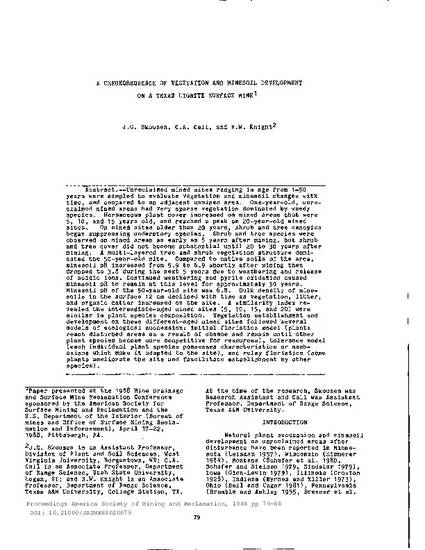
Contribution to Book
Chronosequence of vegetation and minesoil development on a Texas lignite surface mine
Proceedings of the America Society of Mining and Reclamation
(1988)
Abstract
nreclaimed mined sites ranging in age from 1-50 years were sampled to evaluate vegetation and minesoil changes with time, and compared to an adjacent unmined area. One-year-old, unre- claimed mined areas had very sparse vegetation dominated by weedy species. Herbaceous plant cover increased on mined areas that were 5, 10, and 15 years old, and reached a peak on 20-year-old mined sites. On mined sites older than 20 years, shrub and tree canopies began suppressing understory species. Shrub and tree species were observed on mined areas as early as 5 years after mining, but shrub and tree cover did not become substantial until 20 to 30 years after mining. A multi-layered tree and shrub vegetation structure domi- nated the 50-year-old site. Compared to native soils of the area, minesoil pH increased from 5,9 to 6.9 shortly after mining then dropped to 3.8 during the next 5 yeats due to weathering and release of acidic ions. Continued weathering and pyrite oxidation caused minesoil pH to remain at this level for approximately 30 years. Minesoil pH of the 50-year-old site was 6.8. Bulk density of mine- soils in the surface 12 cm declined with time as vegetation, litter, and organic matter increased on the site. A· similarity index re- vealed the intermediate-aged mined sites (5, 10, 15, and 20) were similar in plant species composition. Vegetation establishment and development on these different-aged mined sites followed ·several models of ecological succession: initial floristics model (plants reach disturbed areas as a result of chance and remain until other plant species become more competitive for resources), tolerance model (each fndividual plant species possesses characteristics or mech- anisms which make it adapted to the site), and relay floristics (some plants ameliorate the site and fascilitate establishment by other species).
Disciplines
Publication Date
1988
DOI
DOI:10.21000/JASMR88020079
Citation Information
Christopher A. Call. "Chronosequence of vegetation and minesoil development on a Texas lignite surface mine" Proceedings of the America Society of Mining and Reclamation (1988) p. 79 - 88 Available at: http://works.bepress.com/christopher_call/65/
